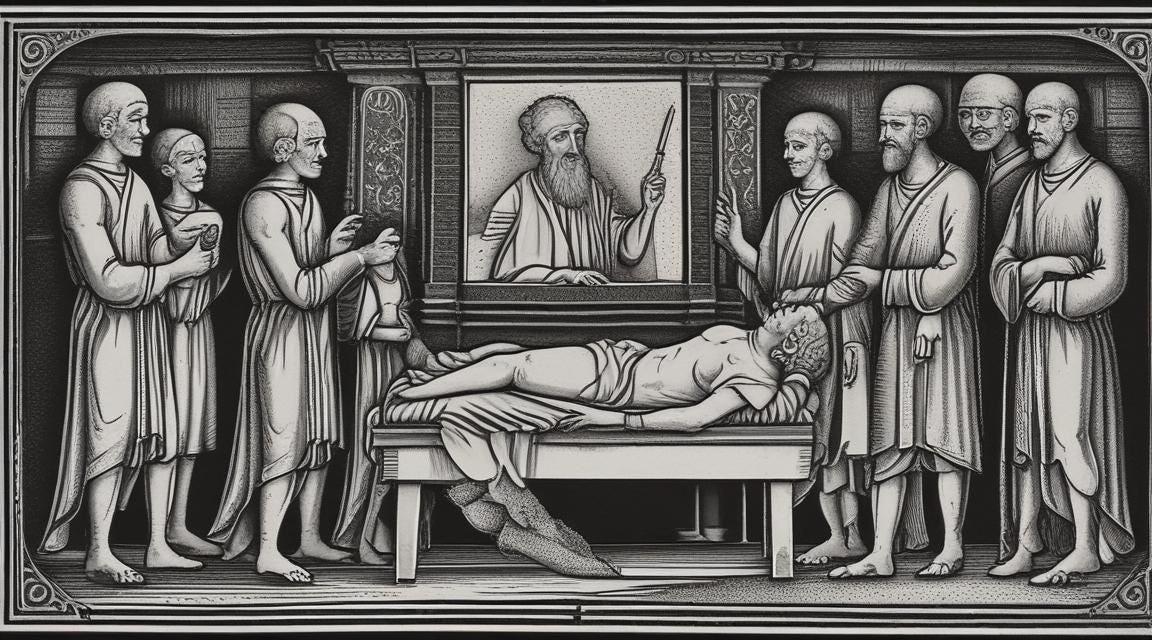A Day In The Life
Why Direct Primary Care May Be Corporate Medicine and the Federal Government's Sworn Enemy
This last Friday was a typical day in our medical practice. Dr. Marconi was enjoying the last of a well deserved vacation. I was attending his and my acute patient cases between performing my Friday managing partner/business agenda.
This day illustrates the benefits of our third party free, direct patient membership practice model. The “we” in the following patient case list includes the doctor and our excellent care staff. Here is a list of some of last Friday’s cases:
An elderly patient presented to the office with malaise, weight loss and upper respiratory symptoms. The past 14 days in our practice we were aware Fort Myers was having a Florida July “surge” of Covid illness. A clinical history and examination was carried out by me. Symptoms, signs and community trends pointed towards Covid infection as the cause. Nasal antigen testing was positive using in-office testing. Prescriptions for management were provided from the office dispensary. The patient was instructed to contact us if his expected recovery trend doesn’t occur. His wife is my patient as well and also reported contracting the same symptoms two days prior. She was offered management as well.
Another patient was seen acutely for an ongoing leg injury with a venous stasis pressure ulcer. I had applied an UNNA wrap bandage 3 days prior to address excess swelling to allow healing. Follow-up examination showed significant improvement and a revised dressing plan was made. Bandages were provided from our office stock. Close follow-up for the next week was planned.
A young, healthy male with a history of brief symptomatic skipping heart beats requested an urgent vitals and ElectroCardioGram tracing. His heart pounding had persisted following being awakened from his early morning sleep. The staff confirmed stable blood pressure measurements but a fast heart rate. The ECG tracing showed clear paroxysmal atrial fibrillation with rapid heart rate response. Many inexperienced providers would call for emergency transport for this presentation. We dosed the patient at the bedside with oral beta blocker medication and observed him through the morning. At 11 am he reported hunger and that he hadn’t eaten since the night before. I went into our kitchen and prepped him two slices of toast with peanut butter and honey, 16 oz. of bottled water and fresh apple slices. By 11:30 his heart rate was improved but he was still running over 100 beats per minute with elevated blood pressures. Another dose of medication was given and by 12:30 PM his blood pressure was normal and his heart rate was trending down. We arrange a nonurgent cash-based echocardiogram referral and initiated full dose aspirin to go with a prescription of the medication that was working. Today as I write this, his office ECG and vitals check confirm he is back in normal sinus rhythm. His weekend was uneventful and he rested at home as advised. He will now return to his self owned business and back to normal activity.
An elderly male who lives in an assisted living facility called the day prior with acute onset of facial swelling and pain. I insisted he come in for an examination. I confirmed early salivary gland infection causing his pain and swelling. He was sent back to his apartment with appropriate antibiotic therapy and instructions for hot compresses and follow-up.
None of these cases were billed additional fees for our office testing and management. IF Dr. Marconi and I were participating in Medicare and insurance payment contracts, we would have been forced to bill various fees, submit codes and provide a long care note in order to maximize coded payment as “proof of care”. We consider any care in the office as part of our patients’ membership service contract. No charge for the peanut butter and jelly. Our patients did pay wholesale prices plus our administrative fee for dispensed medication. It was their preference as they certainly could have tried getting the meds filled and “cleared” by their insurance plan/Prescription Benefit Management scheme.
Medicare and big insurance does not reward citizens who take the responsibility to engage in direct physician care contracting. Both entities are collecting premiums and benefiting from the huge cost savings our model accomplishes. Patients should be pushing back and demanding dropping insurance premiums.
It is my experience, looking at past patients’ hospital Emergency Room bills and care note protocols, that the atrial fibrillation case could have easily resulted in an extended hospital stay and at best, tens of thousands of dollars in billed services. These routine care scenarios explain why outside parties have documented significant total health care cost reductions when patients are engaged in Direct Primary Care practices.
Likewise, in the fee for service model combined with hospital ER access, the leg wound case would have resulted in supply charges for debridement kits at the tune of 600 dollars billed plus the ER room for “surgical procedures”. Upon discharge, there would have been a referral to a hospital owned wound clinic for further management. It is unlikely (in my experience) that the wound team would identify or address the venous congestion as perhaps the main reason for a delay in healing. The wound care clinic model is designed to keep the patient depending upon repeat debridement procedures and appointments.
Had he panicked and self-referred to the emergency department, the elderly gent with salivary gland occlusion/infection likely would have had full lab testing drawn and Computer Tomography x-ray imaging of his face and neck, all billed to Medicare Part B. The ER doctor would have been asked to interpret the labs and imaging likely prior to seeing the patient. It would be likely all testing would have been “normal”. Again- avoiding hundreds to a couple thousand dollars in billed services that weren’t necessary with a proper history and physical examination.
The COVID patients, had they mistakenly presented to the ER would have had full labs, x-rays, and a full Polymerase Chain Reaction infection panel instead of the limited, highest probability for confirmation, COVID antigen test. ER and hospital reimbursement for PCR respiratory panel testing alone is hundreds if not 1-2 thousand dollars per test.
In our model, there is no charge master and care algorithm set up around a ridiculously antiquated, onerous, diagnostic and billing coding system. A proper and brief history combined with very directed testing and treatment strategies were allowed to occur in this physician owned and operated practice. Cost effective and only necessary referrals are recommended. As physician experience occurs, our clinical acumen and diagnostic efficiency and clarity improve. Certainly, non physician care providers start at a lower education and experience acumen. Price-fixing Medicare doesn’t differentiate this fact and promotes the training and licensing of this group of care-givers over doctors. The diagnostic and treatment protocols for liability protection become more important and deeply ingrained in our care models as this rolls out further.
In the Medicare sanctioned and regulated hospital corporate care model, patient’s get excessively tested at the risk of incorrect or incidental diagnoses and management strategies. The institutional care protocols are set up based upon stated complaints at intake. In the interest of “efficiency” and lability risk reduction, testing orders are carried out BEFORE any physician gets to interview and examine the patient. This is extremely wasteful and paradoxically potentially dangerous to any individual being evaluated.
Given how much revenue I prevented versus going to the hospital on Friday, it goes unsaid that this type of effective and competitive care is NOT what the hospital systems want to see. DPC doctors are like guerilla foot soldiers in a movement against the establishment.
I don’t deny the need and role of hospitals and would love for our community doctors to return to accessing the facilities and caring for our patients. It just isn’t in the cards under the status quo, observing government’s most-favored payment schemes, selected for hospital and institutional care.
In the subtitle, I stated our model is likely the government’s sworn health care enemy. This may sound dramatic but let’s look at the facts. Medicare started the physician supply problem when they decided to pay all doctors (and their incidental care team members) the same fees for physician evaluation and management. This went into effect in 1997. It didn’t matter how many years of doctor experience or market preference was present. Everyone gets vanilla ice-cream payment. Eventually everyone is getting vanilla ice-cream with no options for something better or different.
The Medicare system and government regulatory and payment updates have offered minimal additional funding for additional residency slots. Meanwhile with Obamacare the government funded billions of dollars for workforce development including non-physician, primary care degrees. The largest allocation was 15 billion in “loan repayment” incentives for physician debt. That is basically a handout subsidy to non- profit hospitals to recruit primary care doctors fresh out of residency. These potential primary care doctors become inpatient hospitalists and hospital owned clinics attendees. These doctors will never have the opportunity to practice traditional private practice medicine. Unless the DPC guerillas recruit them.
The intent is clear. Uncle Sam intends to put private practice doctors into the dustbin of history and force an inferiorly trained/experienced and unproven cheaper health care work force. Can we say NHS everyone- in unison. And we know that is going over swimmingly. Newly minted physicians are tethered to a 10 year debt forgiveness, institutional employment contract.
Once again, I am stating for the record that government funded and government health care market interference is harming our health care system, both from what is potentially possible and even to whether the profession of medicine survives this generation.
I am coming to the conclusion that our profession needs to seek a new training plan. It starts with a true, honest market needs evaluation and privately funded physician and residency training. The goal being to match society with an appropriate physician work force to meet our citizen’s health care needs. Market efficiency will make the best and most affordable health care available to the most citizens. Stay tuned for a future deeper dive into this topic.









Centene is headquartered in our town. Managers from our “non-profit” hospital frequently move on over to Centene for $1M salaries. What a racket our government has created, making NHS style medicine into large profit centers for managers of medicine. All funded by taxpayers.
Physicians, nurses and patients are never part of the equation.
But…..I know it will turn around. Patients will demand it. Physicians are realizing there’s a huge gap that needs filling. The good ones will comply & smart patients will follow. You’re on the cutting edge doc 😊
MIPS was the final straw for me…. Recall just a week ago Medicare Advantage companies being looked at for bilking. All to be expected.
http://thedoctorsreport.net/2016/10/macra-is-not-smart-or-we-eat-our-own-dont-we-or-will-the-cannibals-please-rise/